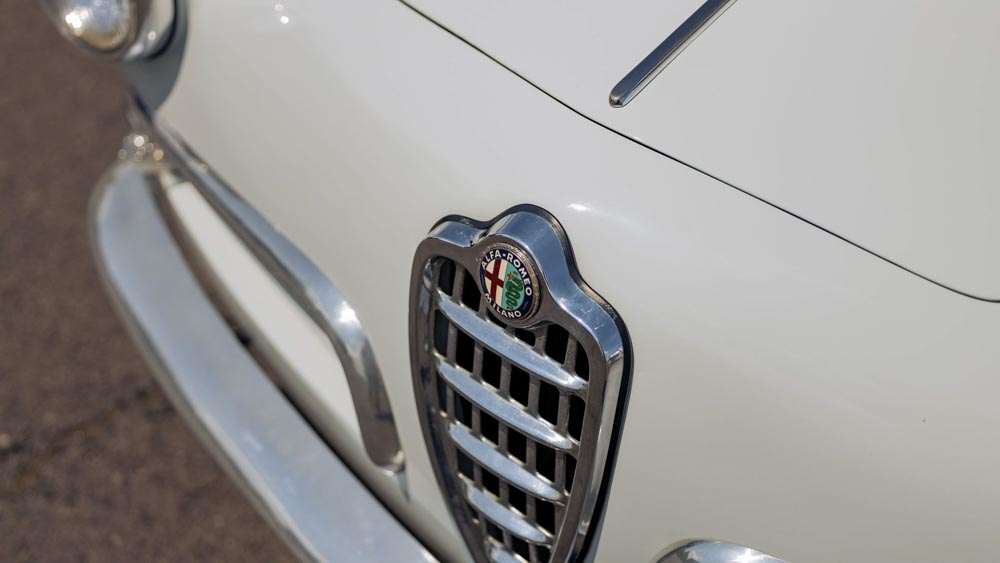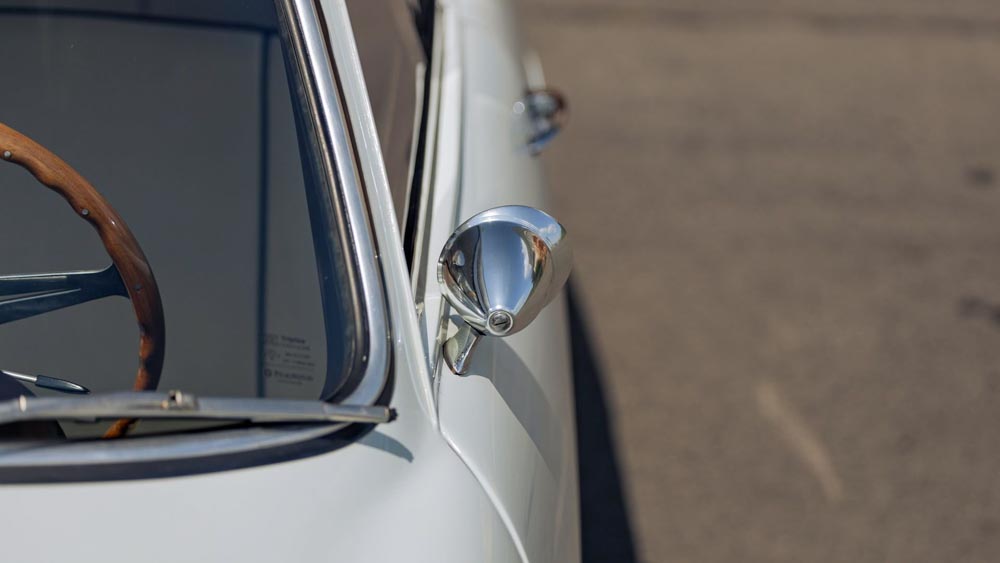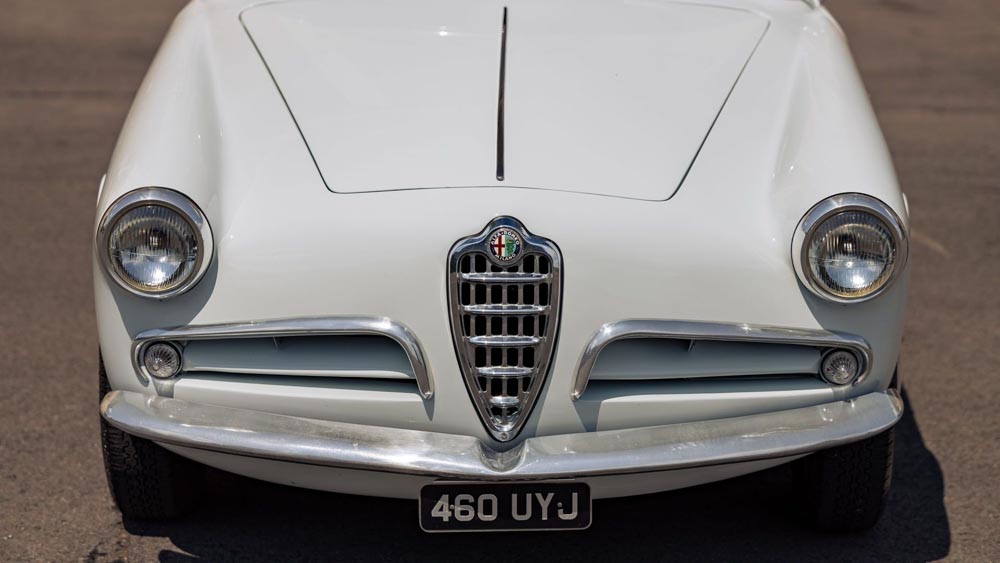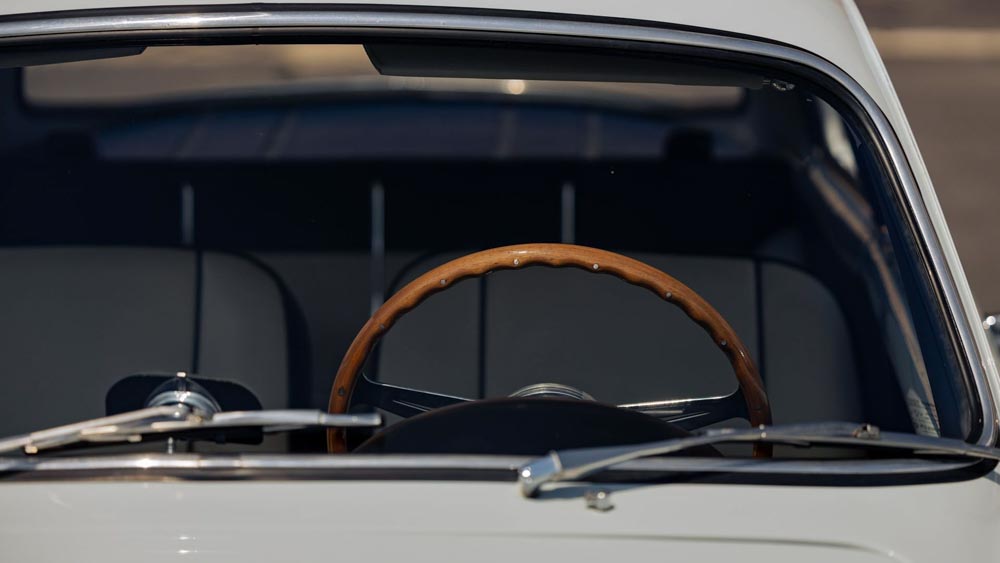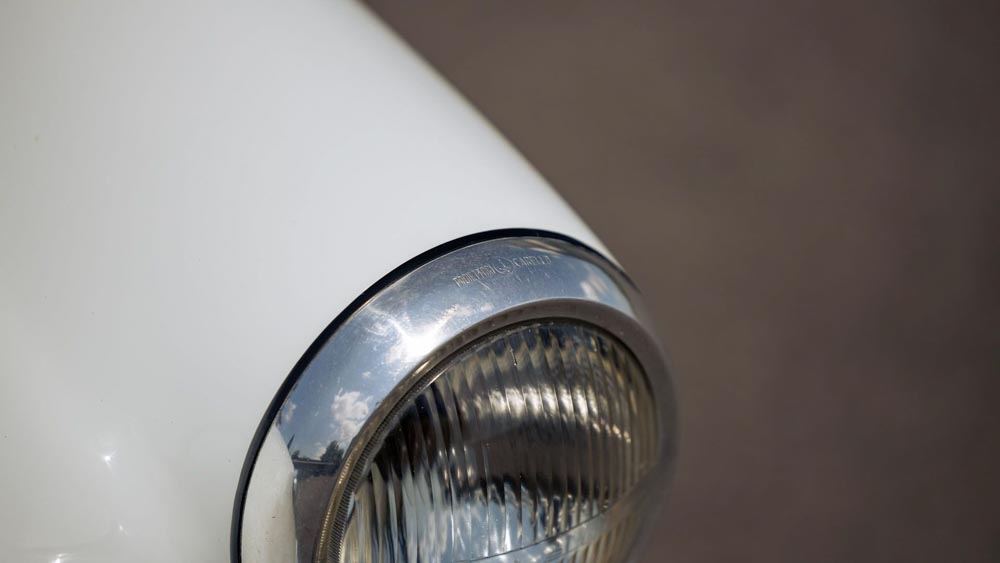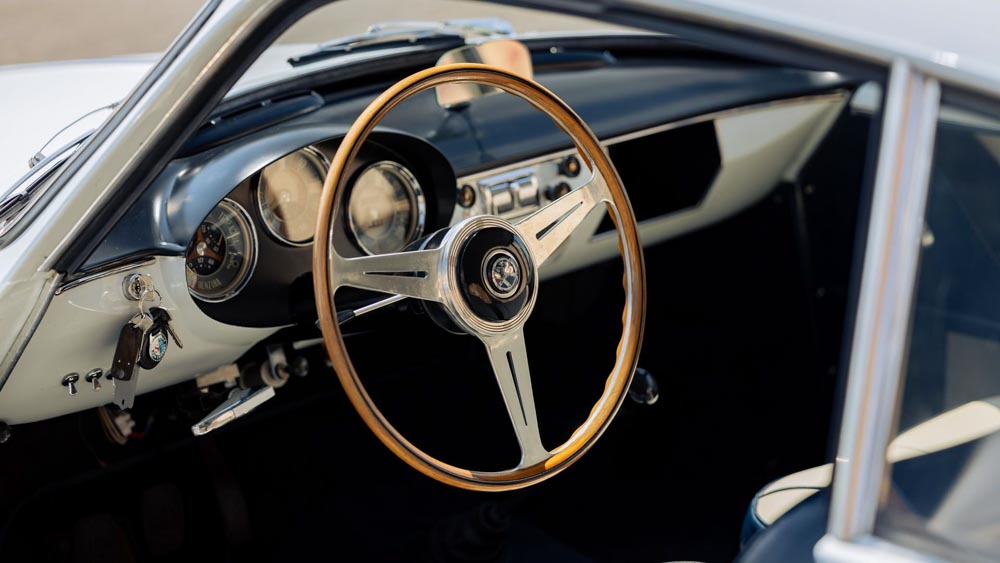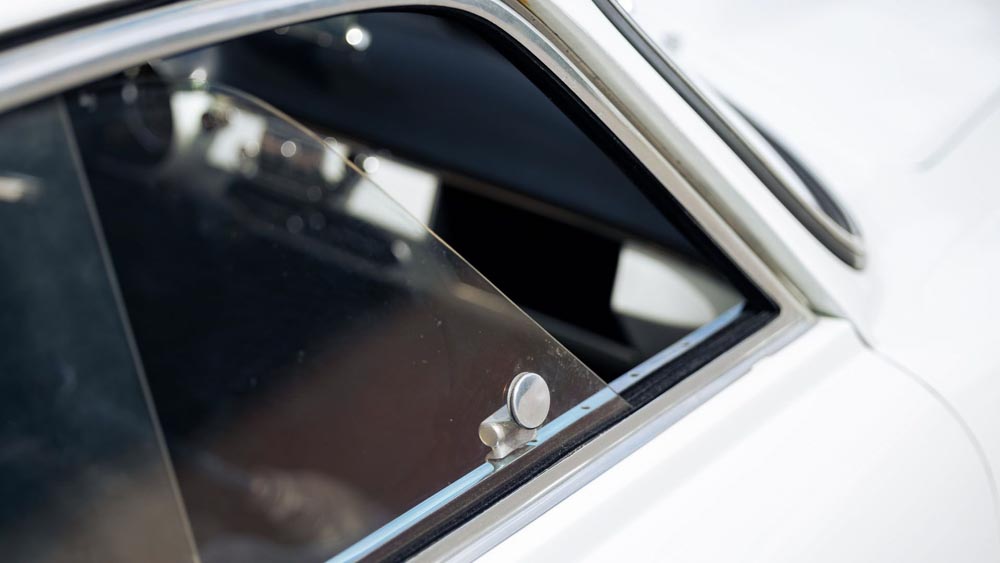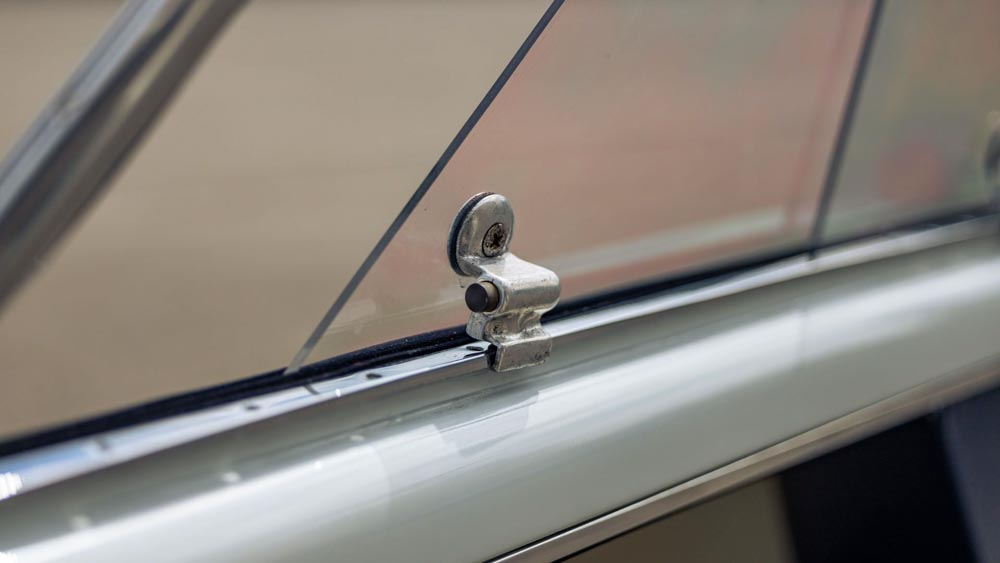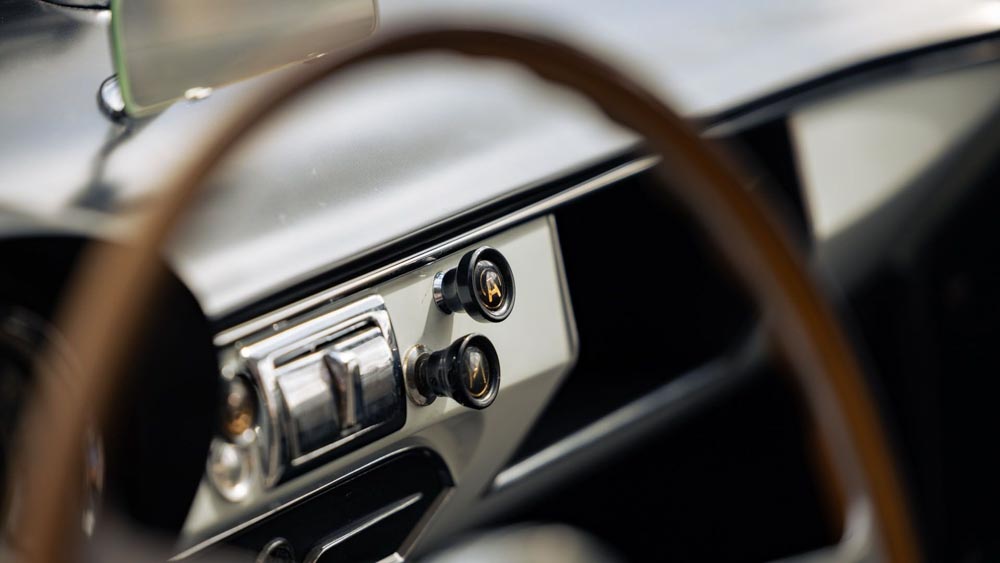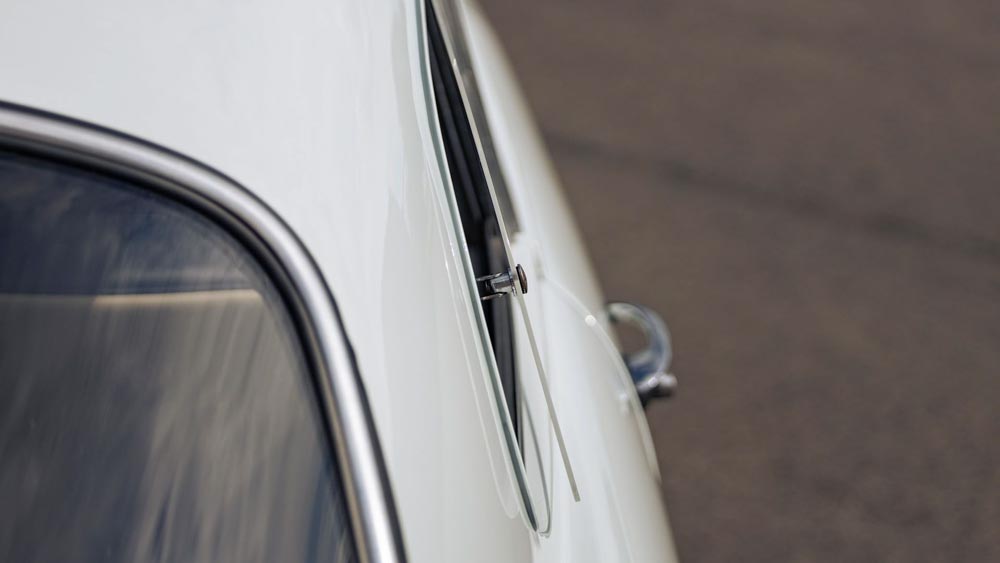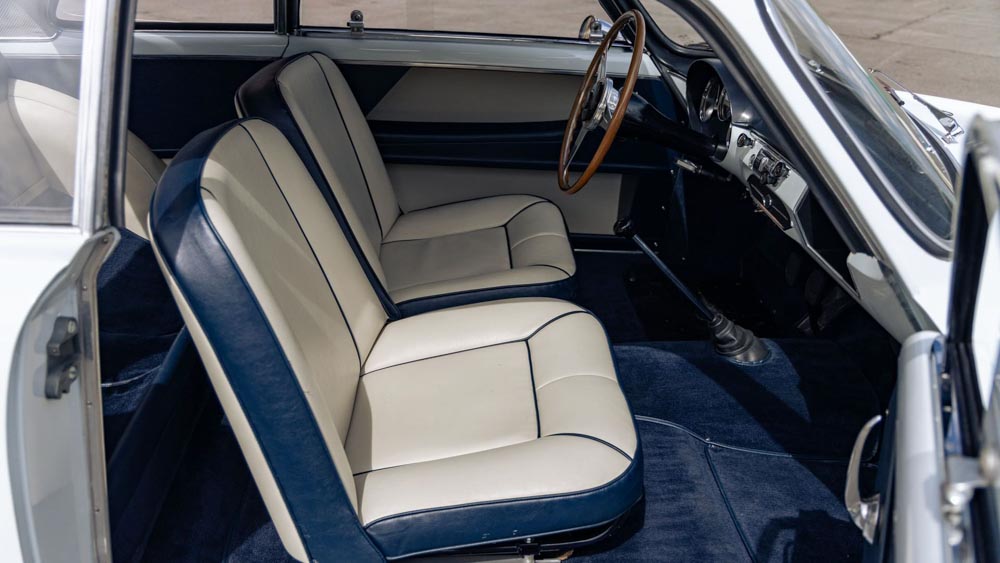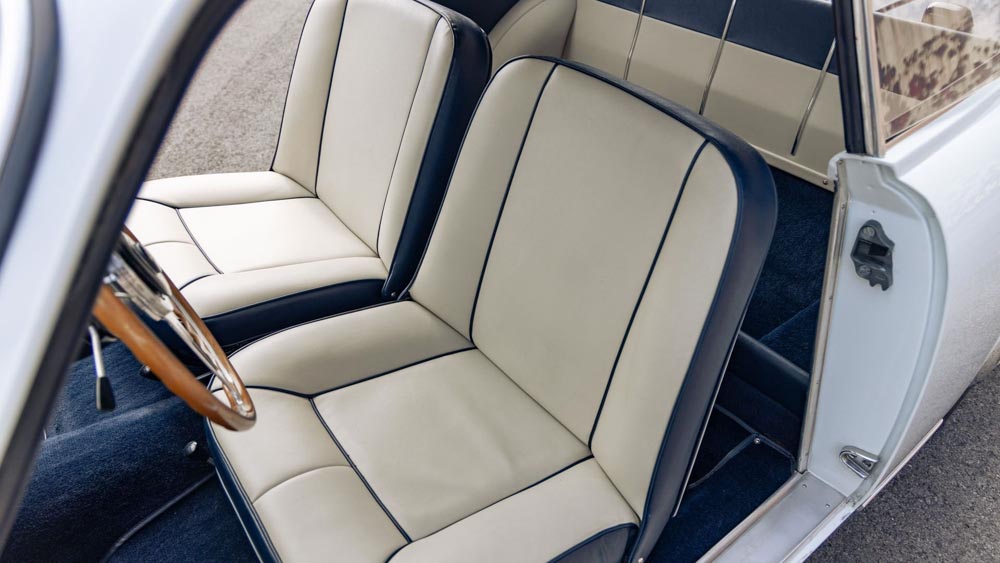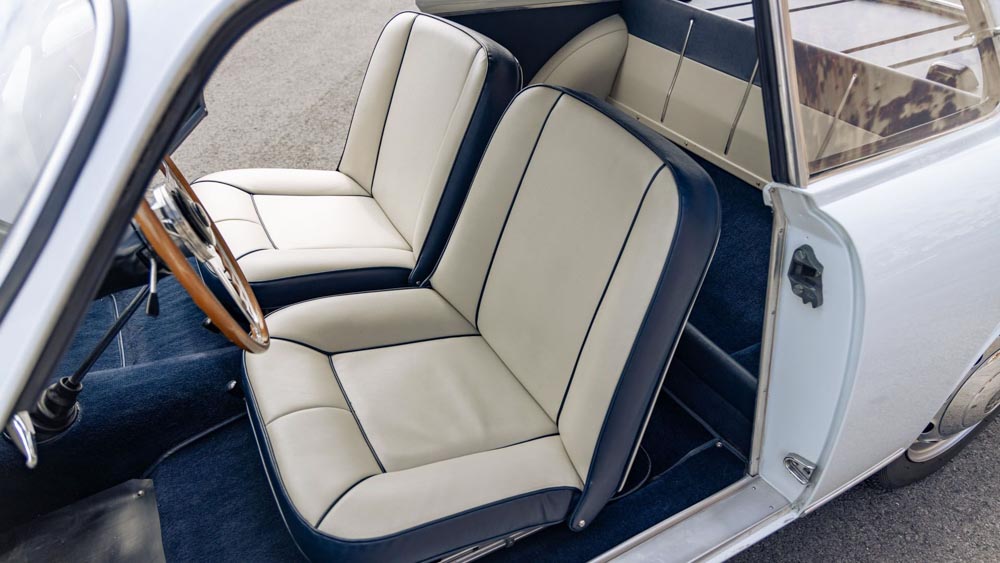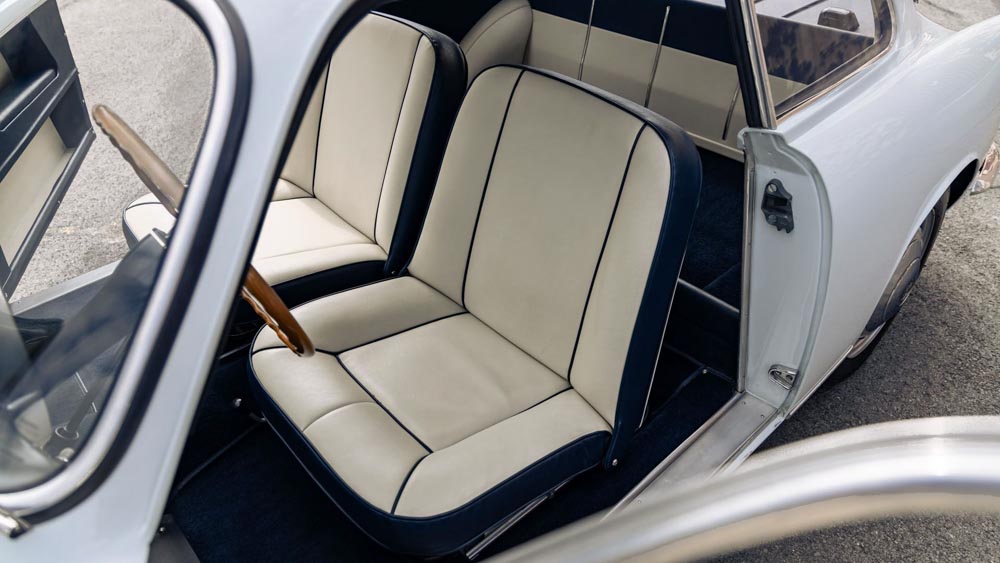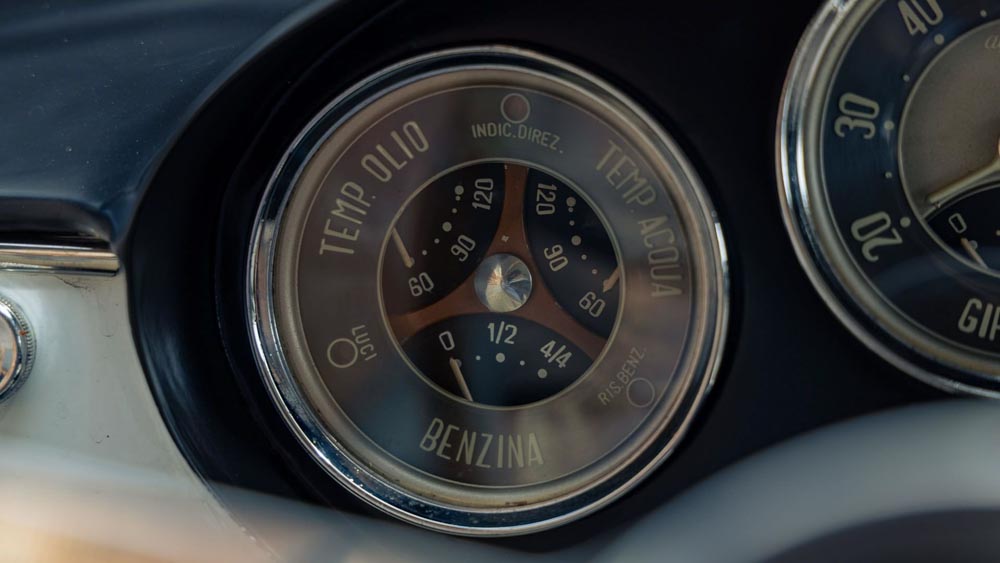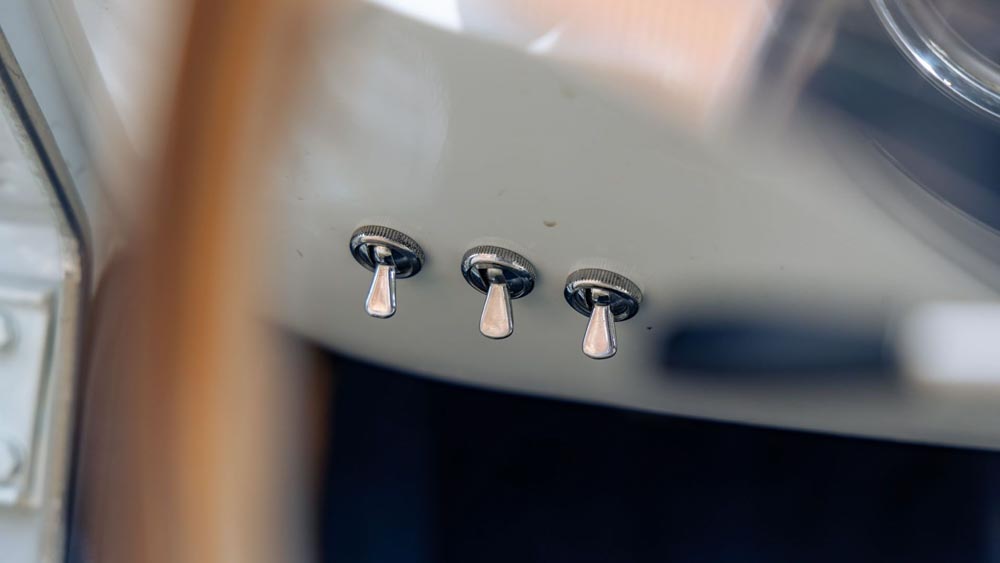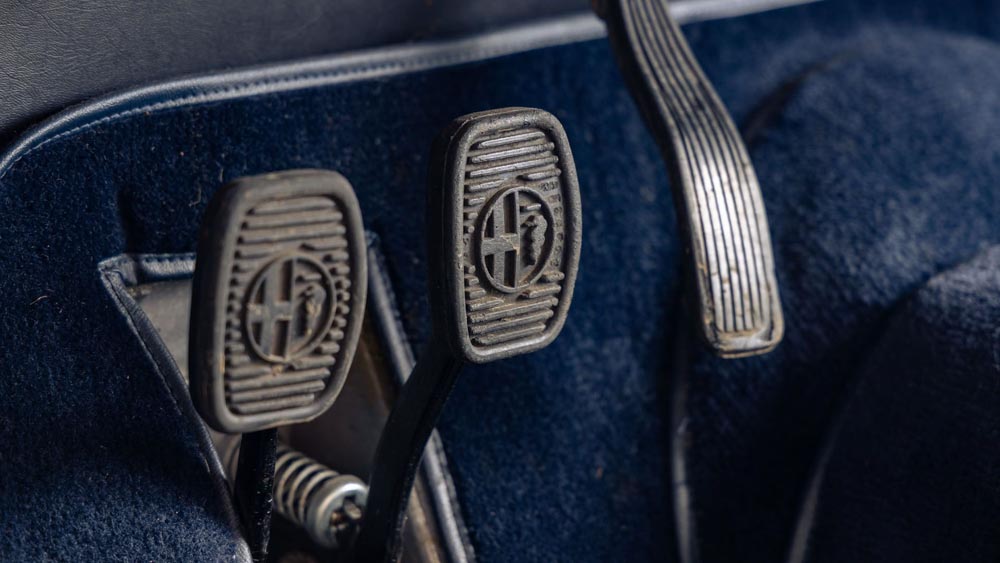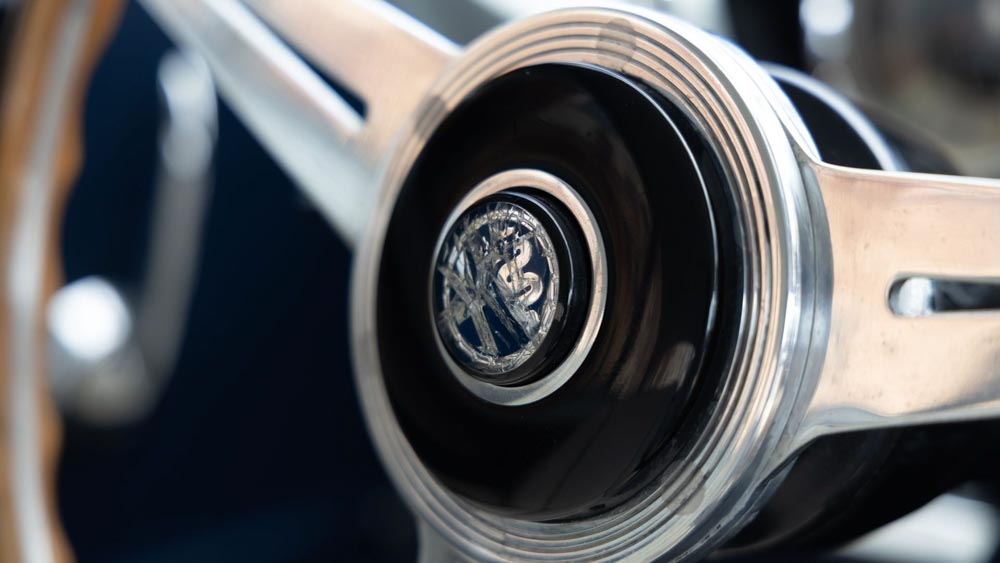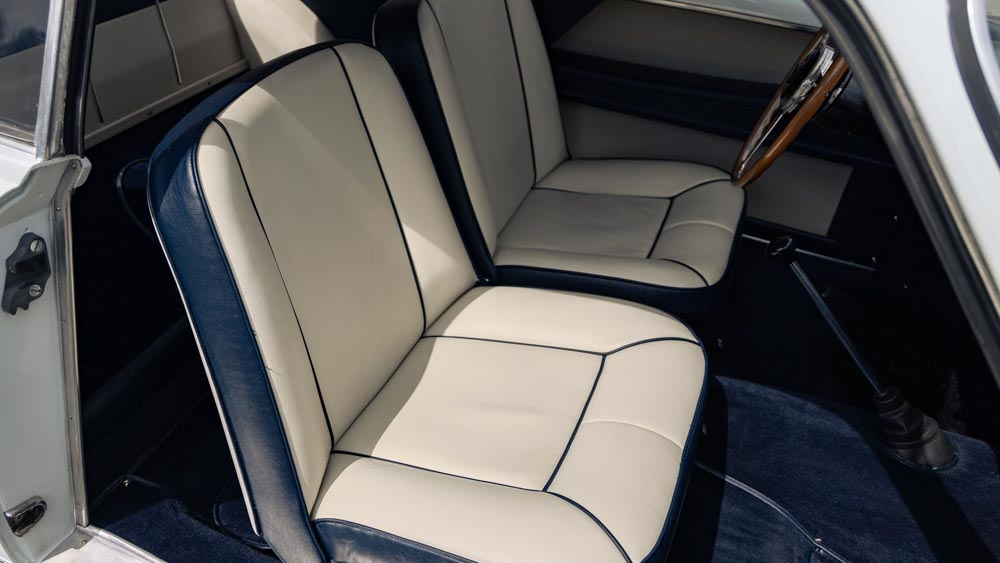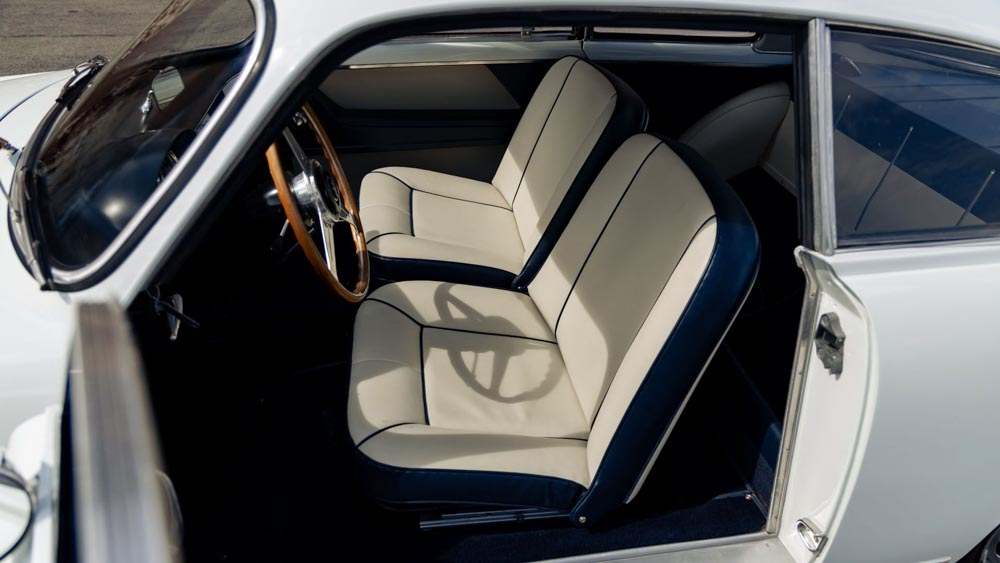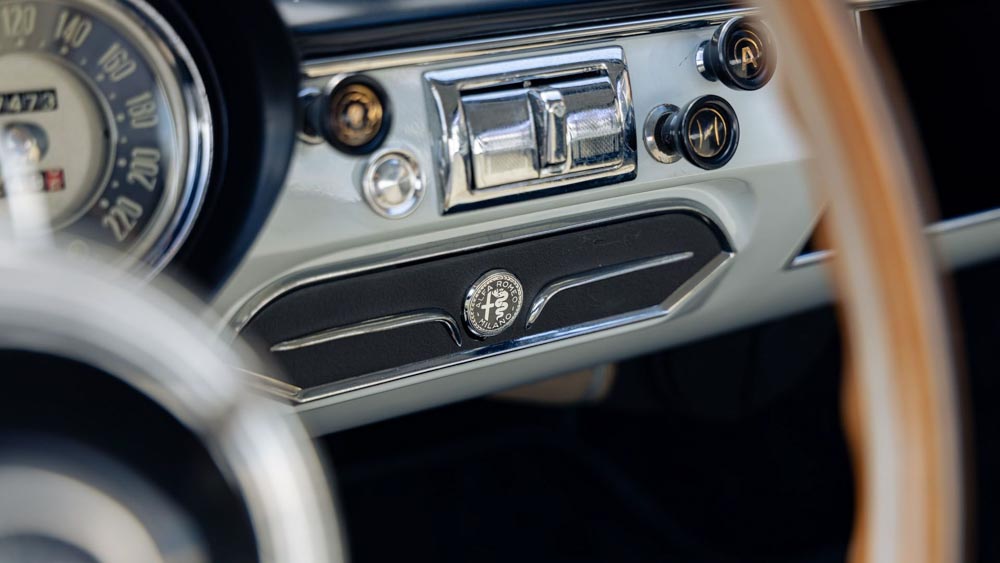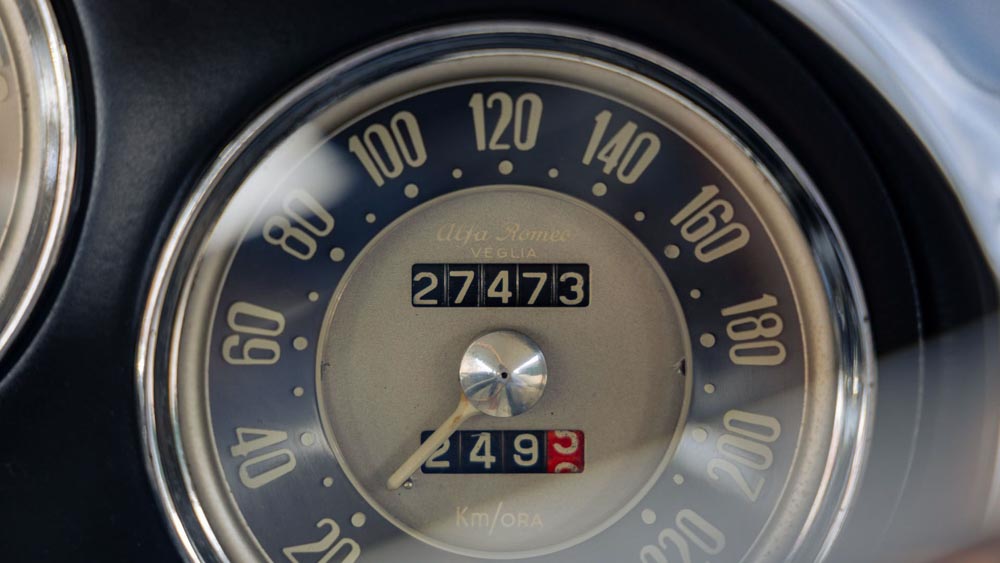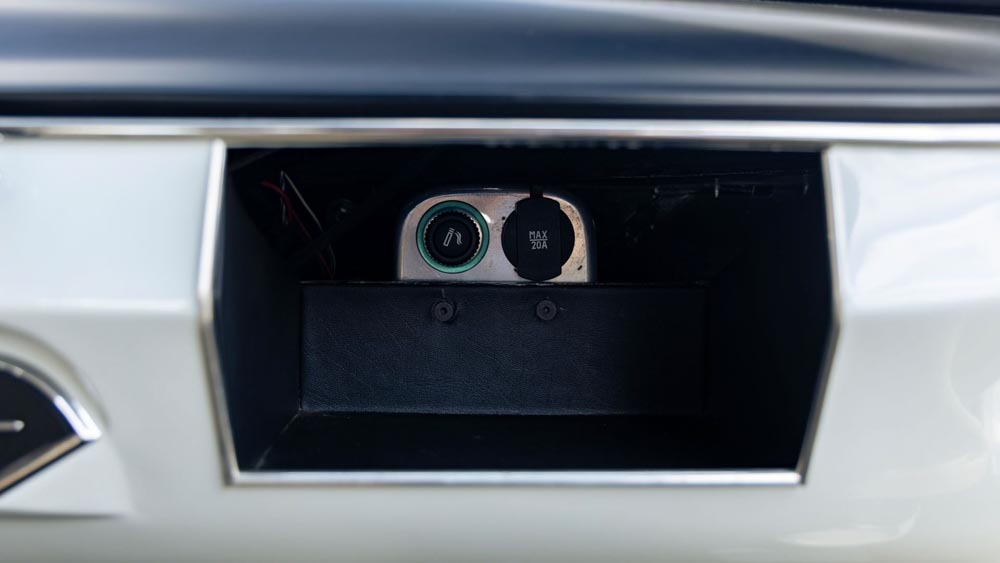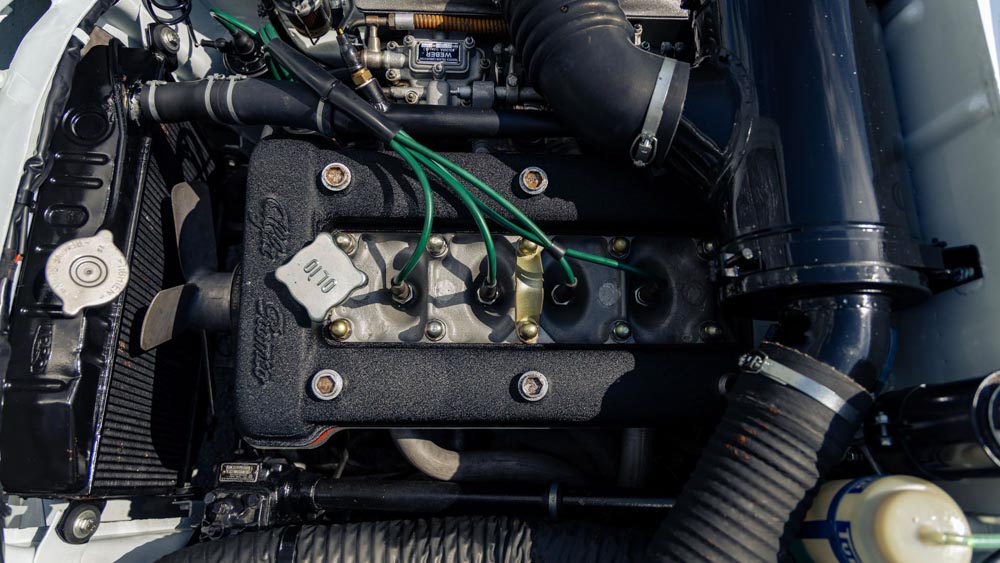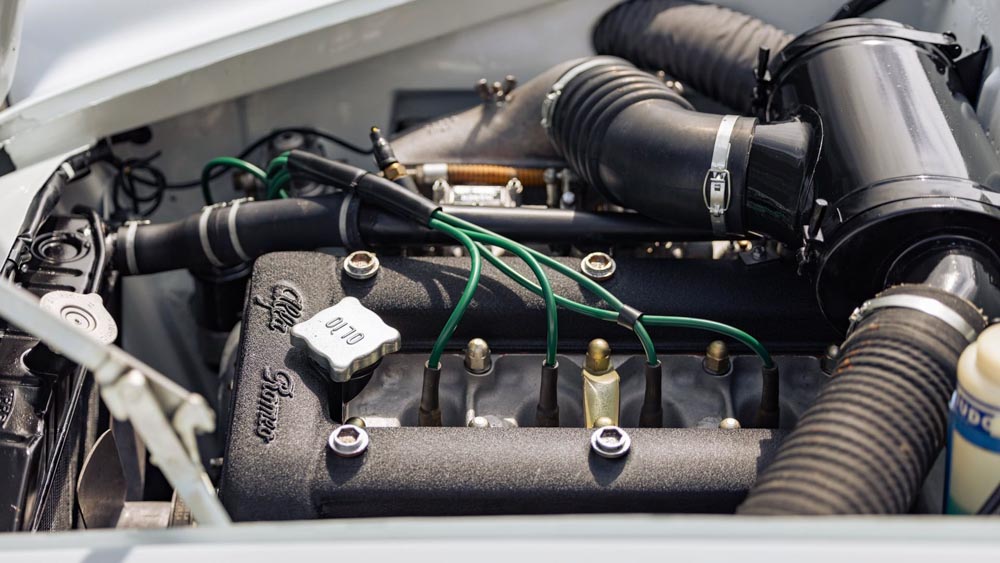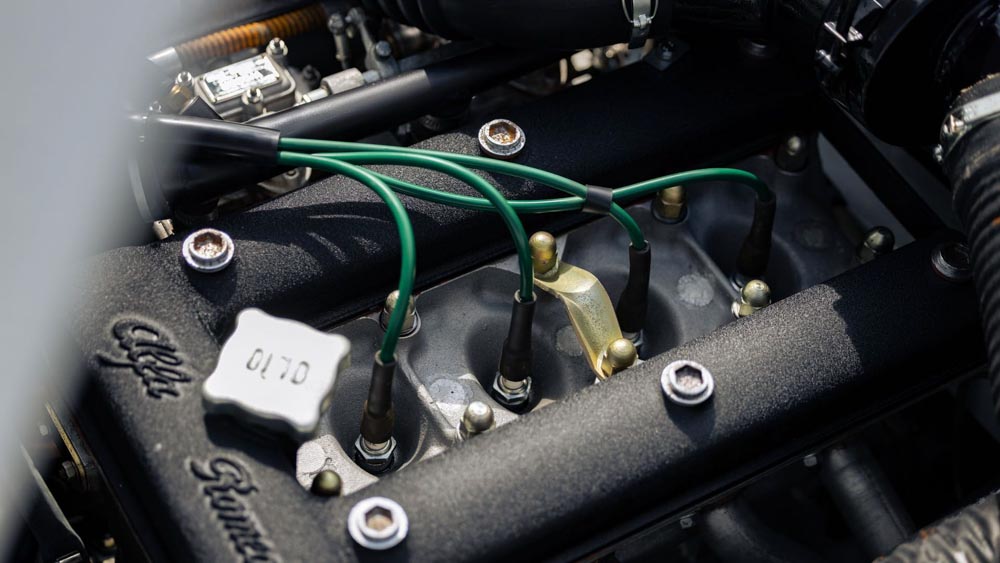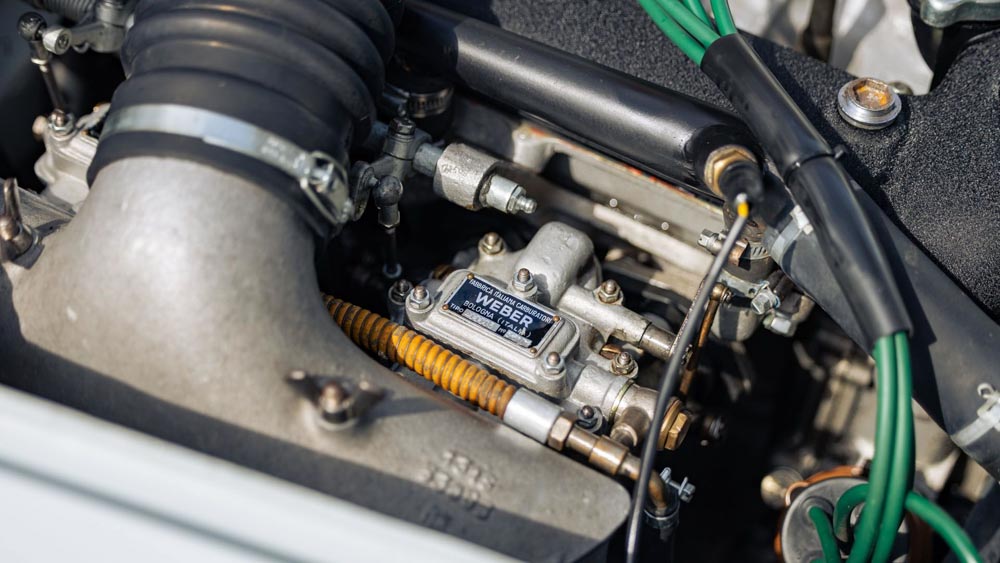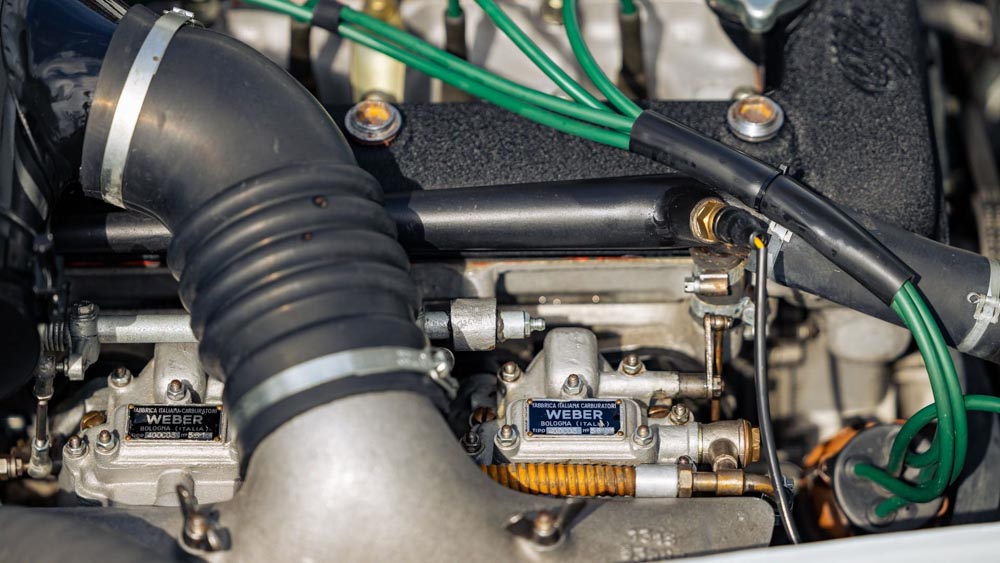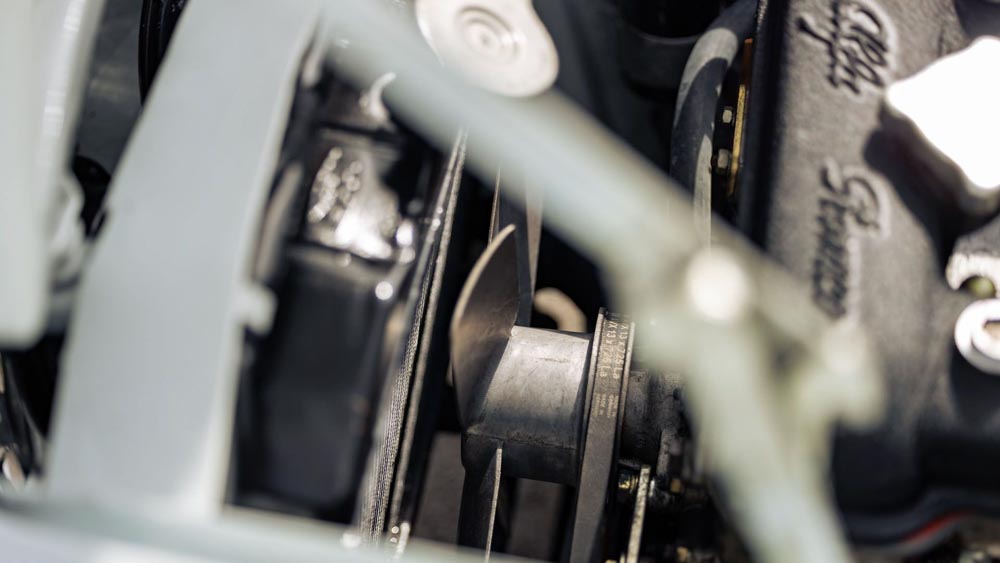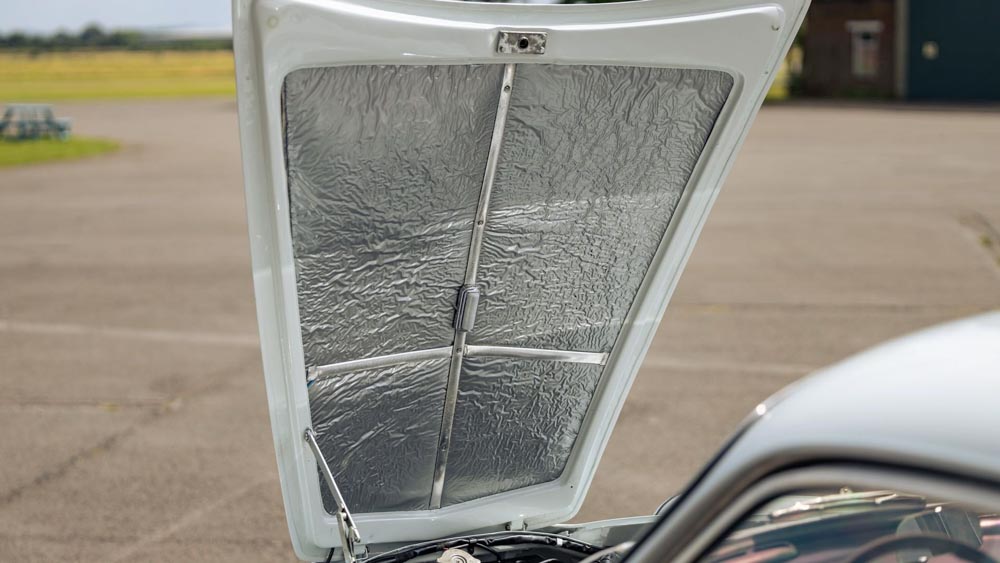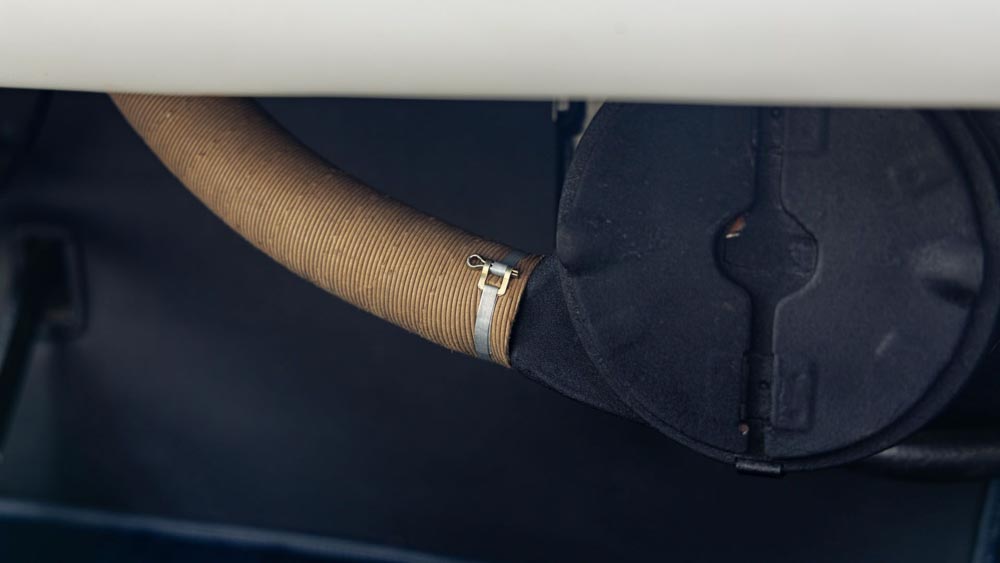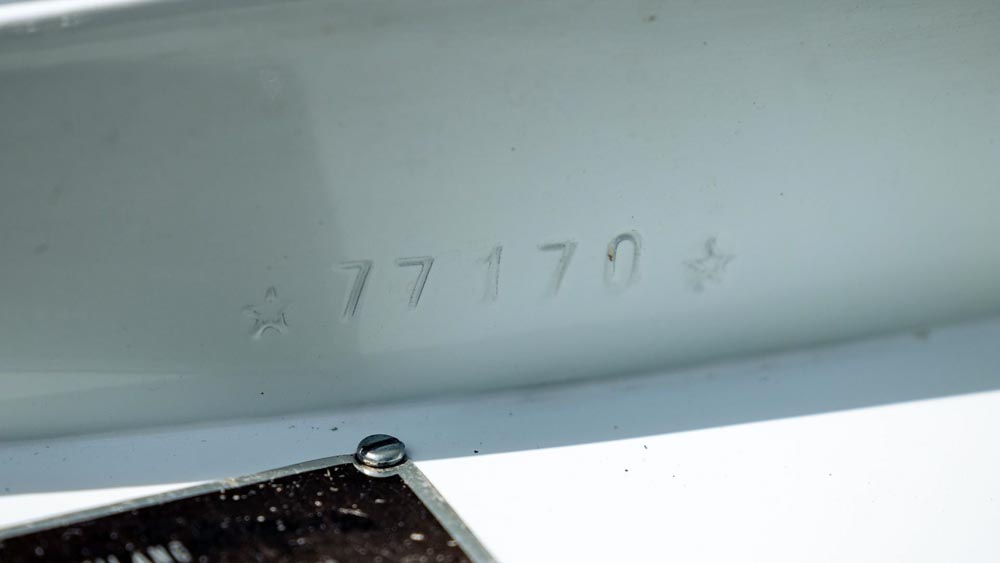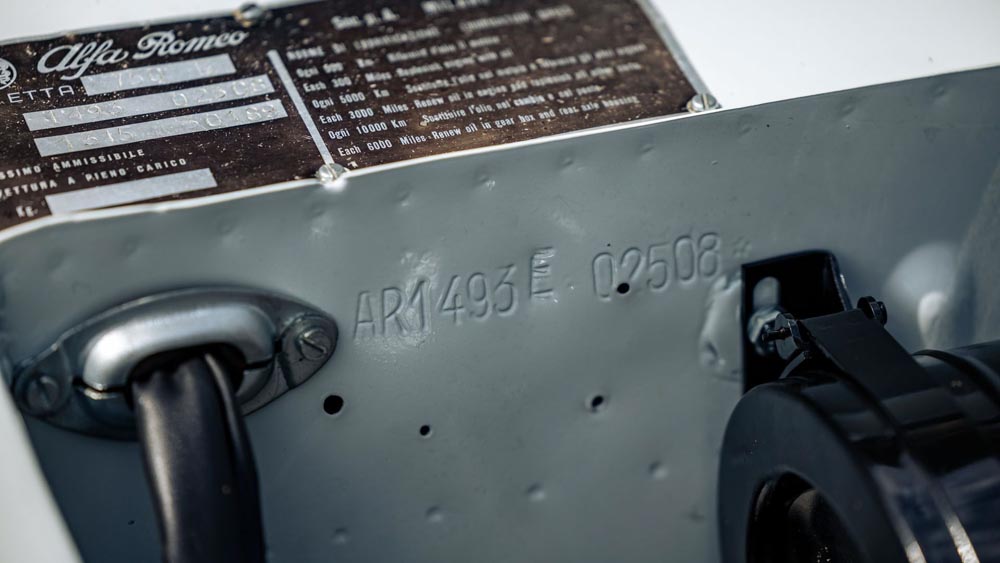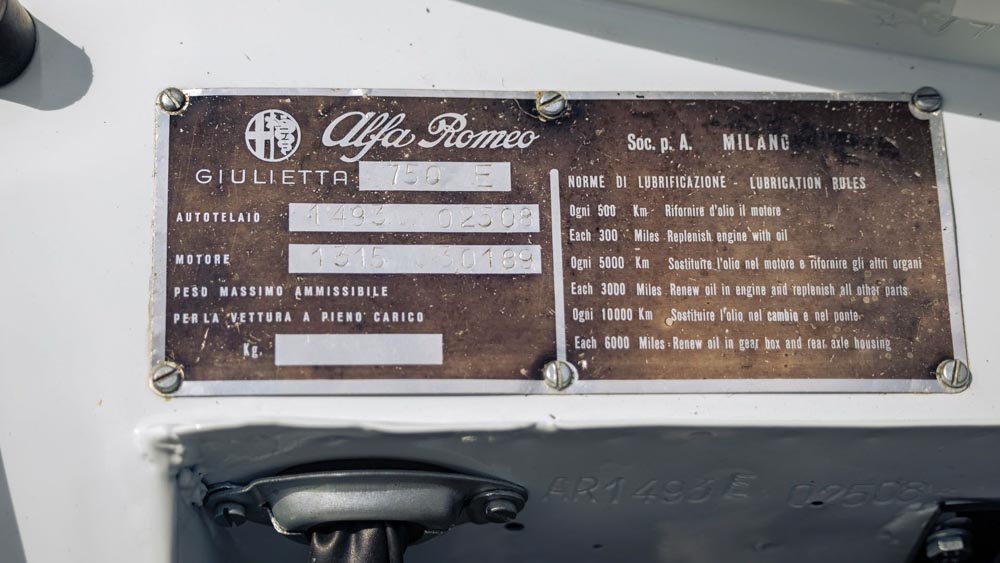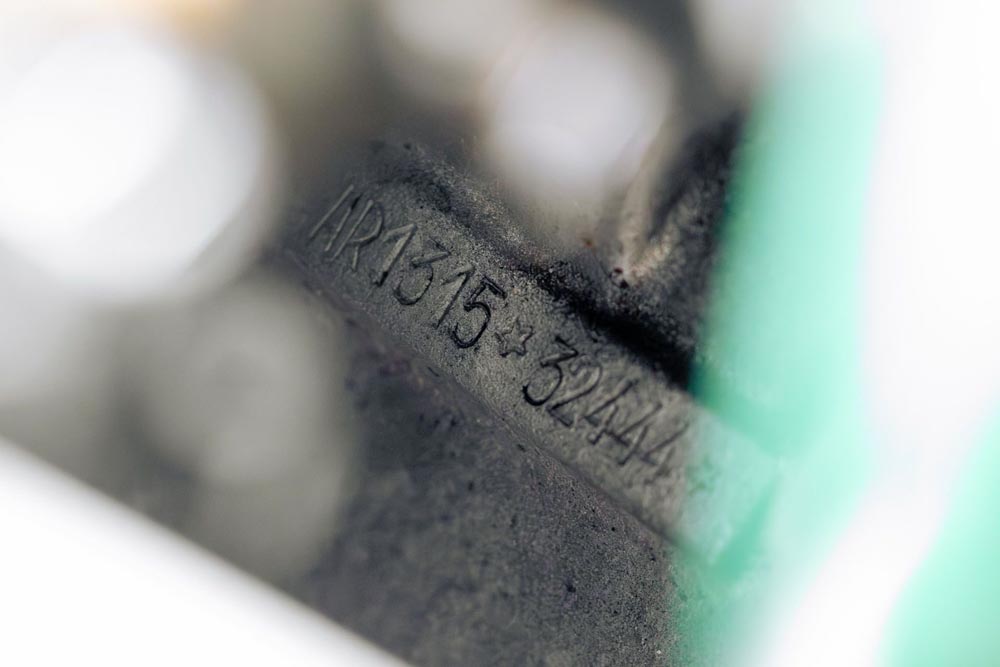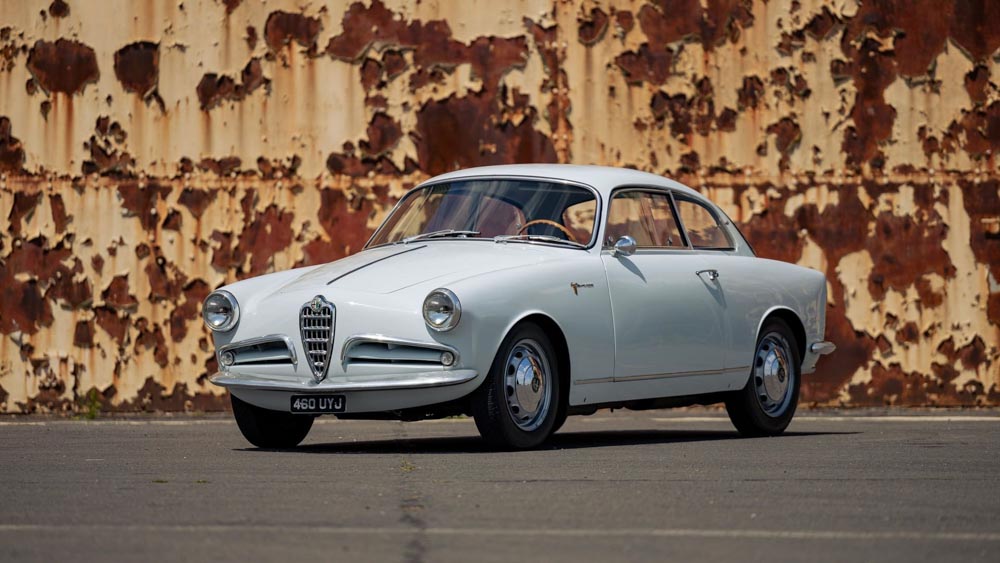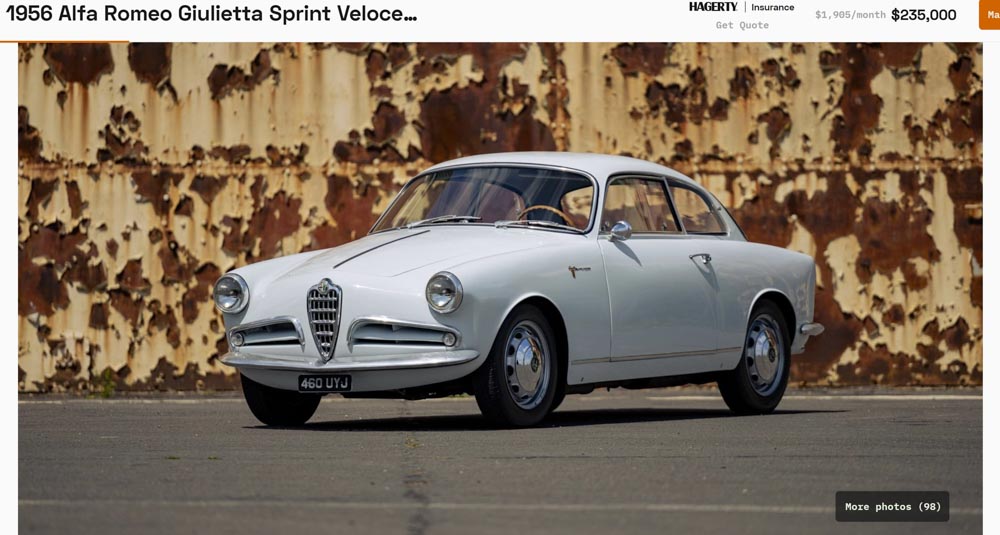September 3, 2014 for sale on RM AUCTIONS London, UK website. Images and text are from the website.
90 hp, 1,290 cc DOHC inline four-cylinder engine with two Weber carburettors, four-speed manual transmission, independent front suspension, rigid rear axle with coil-spring suspension, and four-wheel drum brakes. Wheelbase: 2,250 mm
Period racing history; driven by Swedish F1 racer Joakim Bonnier
Beautifully restored and Mille Miglia eligible
A dramatically altered post-war Italy called for an entirely different kind of sporting car. Alfa Romeo, one of the country’s crown jewels, was quick to oblige with its revolutionary Giulietta, which was unlike any vehicle “Il Biscione” had offered before. The Giulietta debuted at the Turin Salon in 1954 and was thoroughly modern in every way, but it still embodied Alfa Romeo’s racing heritage. To emphasise that latter point, Alfa Romeo debuted the shapely Giulietta Sprint two-door coupé first, before following it up with the still stylish but more pedestrian four-door berlina. The Sprint was penned by Bertone’s Franco Scaglione, and it was remarkably balanced in its aerodynamic design. It was curvaceous without being flamboyant, and it was restrained and graceful.
Slotted under its front-hinged bonnet was Alfa Romeo’s new 1.3-litre, twin-cam four-cylinder. With an aluminium alloy block and a hemispherical cylinder head, the sophisticated motor was so advanced at its debut that its basic design was produced for more than four decades. The mill was fitted with twin Weber carburettors in Sprint Veloce configuration, and it saw a marked increase in power over the 62 horsepower specified for the more workaday four-door berlinas.
With its high-revving nature, the twin-cam motor was a natural fit for competition. Alfa Romeo was prompted by demand from more enthusiastic drivers who had the Mille Miglia and Targa Florio on their minds to offer a limited run Alleggerita, or lightweight, variant that used alloy for the doors, bonnet, and boot lids, as well as sliding side windows to make the most of the available power. The Sprint Veloce Alleggerita was clearly intended for performance over luxury, as it also lacked sound deadening and its rear seat was removed in favour of a simple shelf.
Mechanical modifications included the use of magnesium for the oil pan and intake manifold, as well as a special tachometer to denote their 6,600 rpm redline. A larger 21-gallon fuel tank for long-distance racing was also fitted, which necessitated some modifications to the car’s handbrake cable mechanism. Whilst each of the largely hand-built Alleggerita models was slightly different from the next, they were all designed to maximise the relationship between power and weight. The Alleggerita was notably more responsive and sharp to drive than the standard Giulietta Sprint Veloce, or Normale, and it immediately proved itself to be a serious contender on closed courses.
It is believed that fewer than 600 lightweight examples were assembled, one of which was delivered to Alfa Romeo’s Swedish office for Formula One racing driver Joakim “Jo” Bonnier. Notably, during the mid and late 1950s, the Bonnier family was the official Alfa Romeo importer in Sweden. Bonnier defied his wealthy family’s wish for him to become a doctor by entering into the world of Formula One in 1956 at the Italian Grand Prix. Whilst it’s unclear whether his start at Monza in September inspired him to acquire the Giulietta Sprint Veloce Alleggerita offered here, the timing is notable.
Bonnier, who raced in both Formula One and various sports car competitions, was a quintessential gentleman’s racer of the 1960s. He campaigned this Azzuro Nube Alfa Romeo in several races in 1956, including at the Berlin Grand Prix at AVUS, where he won his class. This SV is also believed to have been driven by Swedish champion Olle Rehnvall in competition during the early 1960s.
This Giulietta Sprint Veloce remained in Sweden until it was restored two years ago under the care of its current owner, and it appears today as it did when its assembly was completed by Bertone in July 1956. This Alleggerita Alfa Romeo, painted in its correct light blue over white and with blue vinyl trim, is undoubtedly one of the nicest examples of this rare lightweight racing breed. Its lightened door panels and other Alleggerita-specific trim pieces are present, marking a stark contrast between this performance model and the more touring-oriented standard Giulietta Sprint. Given its racing history, it is not surprising that its original engine was replaced at some point. The 1,290-cubic centimetre twin-cam engine that was fitted in period is a correct Sprint Veloce powerplant from late 1957. It is said to be in terrific operating order, as is evidenced by its clean and detailed engine bay. Since its restoration, the Sprint Alleggerita has only been sparingly driven, and it remains in superb condition. Included with the sale of the Alfa Romeo are its original delivery and registration documents from Sweden.
This Alfa Romeo Giulietta Veloce Alleggerita brings with it a unique racing provenance and a restoration that is marked by meticulous attention to detail, and it is ready to be enjoyed as its maker initially intended.
ADDENDUM Please note that we believe up to 600 lightweight examples were originally produced as opposed to less than 200 as stated in the catalogue.
UPDATED 9/5/2015 info from MotorStorica website:
Alfa Romeo Giulietta SVA, 1956, frame AR1493 / E02508, approval FIVA 052,173.
Beautiful and perfect, with a new high-performance engine and a unique history, enviable and absolutely documented, Juliet this is another piece of motorsport history that enriches our garage. The subject of a complete restoration in 2012, it is the car with which the late Swedish driver Jo Bonnier took part in the Grand Prix of Berlin of 1956 and is virtually identical to that which took part in the 1000 Miles of the same year. This Sprint Veloce in "lighter" version was built in only 600 copies and is therefore rare car and the price quite challenging destined to watch collectors and lovers of Italian car racing.
MOTORIOUS, STEWART FLORIDA AUGUST 2024
1956 Alfa Romeo Giulietta Sprint Veloce “Alleggerita” Chassis No. AR 1943/E 02508 Engine No. AR 1315 32444 The Alfa Romeo Giulietta Sprint Veloce dominated the 1,300 cc class at the 1956 Mille Miglia, taking the top six places. The Giulietta Sprint Coupé had been outclassed by the Porsche 356 during the 1955 instalment of the Mille Miglia which had motivated Alfa Romeo to significantly improve the performance of the model by reducing weight and increasing the power output. 15th Overall and 3rd in class at the 1956 Mille Miglia was the then 26-year-old Swede, Jo Bonnier. So impressed were Alfa Romeo with his performance that he was gifted an Alfa Romeo Giulietta Sprint Veloce Alleggerita finished in Azzurro Nube the very same car offered for sale here. Bonnier would, of course, go on to compete at the highest level of motorsport in Formula One and continued to have a highly successful career in sports car racing throughout the late 1950s, the entire 1960s and into the 1970s until his untimely passing at Le Mans in 1972. Introduced at the Turin Motor Show in 1954, The Alfa Romeo Guilietta Sprint Coupé, penned by Franco Scaglione at Bertone was a supremely elegant motorcar and suited perfectly the requirement for fast but economical motoring in post-war Italy. Although elegant and possessed with many of the attributes required for competition, the Giulietta was ultimately underpowered and overweight. To address these problems Alfa Romeo first turned their attention to the twin overhead camshaft 1,290 cc four-cylinder engine. Internally the compression ratio was raised from 8:1 to 9:1, larger valves were employed together with more exciting camshaft profiles. Externally the single Solex Carburetor was replaced with two twin-choke Weber 40 DC03 units, and the inlet manifold was designed for better airflow. Power increased from circa 65 horsepower to around 90, with some examples tuned to nearly 100 horsepower. With the enhancement in engine power dealt with, Alfa Romeo turned to the weight problem and for competition minded owners produced around 600 “Alleggerita” (lightened) examples. The Alleggerita featured Plexiglas rear and side windows, the latter being slide operated to avoid the necessity for window winding mechanism. Together with the lights the windows were surrounded by lightweight aluminum trim. The bumpers were also made from aluminum. In terms of bodywork, lighter steel was used for non-lead bearing panels and aluminum was again employed for the doors, bonnet and boot lid. Internally the seats were thinner, and foam padded, not sun visors or glovebox was provided. Even the doors had foam padded arm rests and option nets for carrying items. Overall, the weight was reduced by some 15 percent to around 770 kilograms. Further performance enhancements included a floor-shift gear leaver and a 65-liter fuel tank with the option of an 80-liter tank for endurance racing. Aside from class dominance at the Mille Miglia the Alleggerita Alfa Romeos claimed class wins at the Tour De France, Nürburgring 1000 kms and outright victory in the Alpine Rally, to name but a few. This example, chassis number AR 1943/E 02508, was gifted new to Jo Bonnier, part of the wealthy Bonnier family, who were the Swedish importers for Alfa Romeo. Bonnier used the Alfa Romeo for competition purposes and on file is a fantastic photograph of the car on the steep banking at AVUS. This photograph of Bonnier was taken during the 6th round of the German Sports Car championship, at the Berlin Grand Prix event, where he was victorious in his class. It is thought that the Alfa Romeo was also driven in competition by Olle Rehnvall in numerous Swedish events during the early 1960s. The car remained in Sweden until 2012 when it changed hands and was fully restored over a two-year period. The original engine had long since been replaced, perhaps no surprise given the competition history of the car. The current engine, number AR 1315 32444 is reported to be a correct type 1,290 cc Sprint Veloce unit from 1957. Post restoration, the delectable Alfa Romeo was acquired by Alain de Cadenet, a famous Alfisti and, of course, ex-Le Mans racer and team owner during the 1970s and 80s. A great loss to the motoring world, Alain passed away in 2022 and today the Alfa Romeo is offered for sale directly from his family. Of the circa 600 Alfa Romeo Giulietta Sprint Veloce "Alleggerita” produced it is thought that only around 10 percent are known to have survived. No doubt all are desirable, but this example with previous Formula One Ace ownership and competition use in period, must surely be one of the most exciting examples to have survived. The very fact that Alain De Cadenet selected the car for his personal collection is telling as to the quality of the car and its provenance. Eligible for a plethora of top-flight events such as the Mille-Miglia, Tour Auto and Le Mans Classic. The new owner will be able to enjoy the “Alleggerita” Alfa Romeo's enhanced performance and lightweight construction to the maximum in historic events all over the world. Jo Bonnier Joakim “Jo” Bonnier was a prolific racing driver and the first Swede to both race in Formula One and win a Grand Prix. A works driver for the likes of Maserati, BRM, and Porsche he competed in the sport's top category between 1956 & 1971. As was commonplace at the time he also competed at the front of sports and GT racing and was a 13-time starter at the Le Mans 24 Hours with a best result coming alongside Graham Hill in 1964 in a Ferrari 330P3 where the duo finished 2nd overall. Tragically in the 1972 running of the race, he was killed when he crashed a self-entered Lola T280. Earlier in his career and on his way up through the ranks Bonnier owned and raced numerous small capacity Alfa Romeo's and competed across Europe in events such as the Mille Miglia. Cutting his teeth in such machines allowed him to forge a reputation which then led to him becoming one of the most recognized and respected names of the period. Racing Results September 16th, 1956, Berlin Grand Prix AVUS, Joakim Bonnier, 1st Overall (124.8kms, 43.39.100) February 7th, 1960, Corsa sul ghiaccio a Mjölby, Olle Rehnvall, 1st in Class February 21st, 1960, Corsa sul ghiaccio a Hedemora, Olle Rehnvall, 1st in Class February 28th, 1960, Corsa sul ghiaccio a Härnösands, Olle Rehnvall, 1st in Class March 7th, 1960, Corsa sul ghiaccio a Brunnsviksloppet, Olle Rehnvall, 1st in Class June 12th, 1960, Tourist Trophy a Karlskoga, Olle Rehnvall, 1st in Class July 10th, 1960, Tourist Trophy della Costa Ovest, Olle Rehnvall, 1st in Class August 7th, 1960, Corsa a Karlskoga, Olle Rehnvall, 1st in Class



































